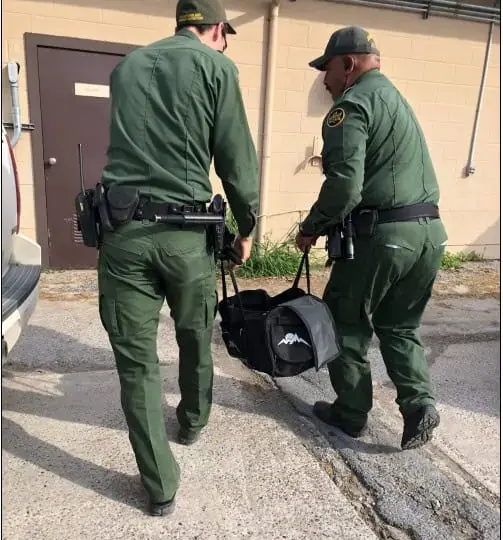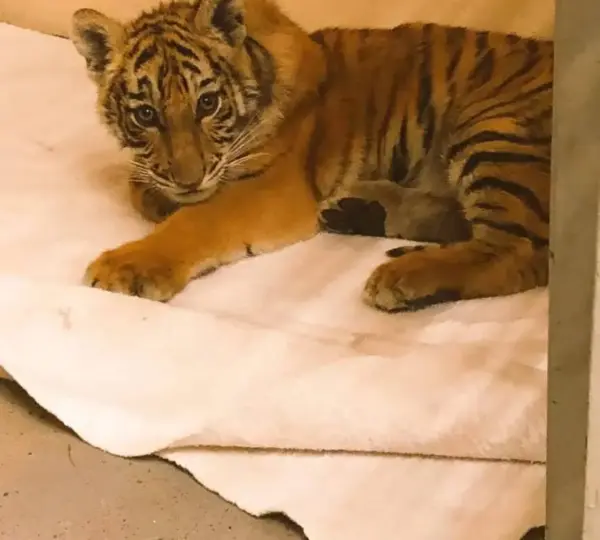The sun was slowly dipping below the horizon over Brownsville, Texas, painting the sky in hues of orange and pink as the shadows along the Rio Grande lengthened and darkened. For the Border Patrol agents stationed in this part of the country, dusk marked a particularly tense time of day. The shifting light offered cover to countless groups—migrants seeking safety, smugglers transporting contraband, and traffickers exploiting vulnerable lives, both human and animal. The borderlands are a place of constant vigilance, where every shadow could conceal danger or desperation.
On this particular evening, the agents noticed three men moving cautiously along the river’s muddy bank. One of the men carried a large, heavy black duffel bag that looked oddly misshapen, almost as if something alive was inside. The group hurried, casting nervous glances back as the agents closed the distance. Suddenly, without warning, the men abandoned the bag and disappeared into the dense brush, their footsteps quickly swallowed by the thick undergrowth.
The agents approached the abandoned duffel bag with caution, unzipping it slowly to reveal an unexpected sight—a tiny tiger cub, no more than three or four months old, trembling, weak, and struggling to breathe. The animal’s fur was damp and dirty, and its little chest rose and fell with shallow, uneven breaths. There was no sign of the men or any explanation for why this vulnerable creature had been left alone on the riverbank.
The discovery sent shockwaves through the team. This was not the typical haul of drugs or weapons that agents often intercepted, but a living, breathing life—an endangered animal subjected to the horrors of the illegal wildlife trade. The cub’s condition was fragile, and the agents acted immediately, calling in wildlife rescue experts and rushing the cub to the nearby Gladys Porter Zoo.

At the zoo, a dedicated team of veterinarians and animal care specialists worked around the clock to stabilize the cub, whom they soon named “Zuko.” The staff administered fluids to combat dehydration, provided warmth to regulate his body temperature, and monitored his vital signs carefully. Zuko’s survival was uncertain; his early moments at the zoo were critical. Slowly but surely, the cub began to respond, opening his eyes and showing signs of improved strength and alertness.
This rescue was far from just a single act of kindness—it shone a spotlight on a pervasive and devastating issue. While the survival of this cub offered hope, it also underscored the grim reality facing tigers worldwide. According to conservation experts, fewer than 3,200 tigers remain in the wild today, their populations devastated by habitat loss, poaching, and illegal trafficking. Paradoxically, more tigers live in captivity in the United States—estimated at around 5,000—than survive in their natural habitats across Asia.
Unfortunately, many of these captive tigers exist outside of accredited zoos and conservation programs. Instead, they are found in roadside menageries, private exotic pet collections, and unregulated breeding facilities where oversight is minimal or nonexistent. The illegal exotic pet trade thrives on demand for rare and dangerous animals, driven by a mix of ignorance, status-seeking, and sheer greed. These tigers, once stolen or bred illegally, often suffer in cruel conditions—malnourished, neglected, and denied the environments they need to thrive.
The trafficking networks behind these animals are highly organized, using covert routes to smuggle cubs across borders, sometimes hiding them in bags, crates, or cages in transit points like border crossings. The exploitation of wildlife in this way is a multifaceted crime, intersecting with issues of human trafficking, drug smuggling, and organized crime, complicating enforcement efforts.

Zuko’s rescue, therefore, was not just about saving a single cub. It became a symbol of the broader fight against wildlife trafficking and the urgent need for enhanced law enforcement, international cooperation, and public awareness. Each rescued animal represents not only a life saved but also a victory against the shadowy global trade that threatens to wipe out endangered species.
The Gladys Porter Zoo and other conservation organizations continue to advocate for stronger laws and better enforcement at borders and within the exotic pet trade. Efforts include cracking down on illegal sales, improving regulations on private ownership, and educating the public about the devastating consequences of buying exotic pets.
Beyond the legal and conservation challenges, there is an emotional side to this story. For those who witnessed Zuko’s rescue and recovery, it is a powerful reminder of the capacity for compassion and action in the face of cruelty. The team that cared for Zuko grew attached to him, investing time, effort, and hope into giving him a second chance. For the little tiger, survival was a narrow path paved by quick decisions, expertise, and kindness.
The incident also raised difficult questions about the roles and responsibilities of border enforcement agents, who often find themselves on the frontlines of not only immigration and drug control but also wildlife protection. Training, resources, and protocols are increasingly needed to help agents recognize and respond to cases of animal trafficking, which can be hidden amid more conventional crimes.
As Zuko grows stronger in his sanctuary, his story is shared widely—reminding the public that wildlife trafficking is not a distant problem but a crisis happening here and now. It calls for vigilance from citizens, lawmakers, and enforcement agencies alike.
Ultimately, this tale is not just about one tiger cub found in a duffel bag on the banks of the Rio Grande. It is a reflection of a global struggle to protect endangered species from extinction and to confront the dark networks that profit from their suffering. For every cub rescued, many others remain hidden, captive, or lost. The fate of tigers like Zuko hangs in the balance, reliant on human determination to protect, preserve, and restore.
This story is a plea—a plea to see beyond the borders, beyond the shadows, and recognize that the survival of these majestic animals depends on collective action and unwavering commitment. The road ahead is long, but the rescue of Zuko offers a beacon of hope—a reminder that even in the darkest moments, life can prevail, and change is possible.
The sun was slowly dipping below the horizon over Brownsville, Texas, painting the sky in hues of orange and pink as the shadows along the Rio Grande lengthened and darkened. For the Border Patrol agents stationed in this part of the country, dusk marked a particularly tense time of day. The shifting light offered cover to countless groups—migrants seeking safety, smugglers transporting contraband, and traffickers exploiting vulnerable lives, both human and animal. The borderlands are a place of constant vigilance, where every shadow could conceal danger or desperation.
On this particular evening, the agents noticed three men moving cautiously along the river’s muddy bank. One of the men carried a large, heavy black duffel bag that looked oddly misshapen, almost as if something alive was inside. The group hurried, casting nervous glances back as the agents closed the distance. Suddenly, without warning, the men abandoned the bag and disappeared into the dense brush, their footsteps quickly swallowed by the thick undergrowth.
The agents approached the abandoned duffel bag with caution, unzipping it slowly to reveal an unexpected sight—a tiny tiger cub, no more than three or four months old, trembling, weak, and struggling to breathe. The animal’s fur was damp and dirty, and its little chest rose and fell with shallow, uneven breaths. There was no sign of the men or any explanation for why this vulnerable creature had been left alone on the riverbank.
The discovery sent shockwaves through the team. This was not the typical haul of drugs or weapons that agents often intercepted, but a living, breathing life—an endangered animal subjected to the horrors of the illegal wildlife trade. The cub’s condition was fragile, and the agents acted immediately, calling in wildlife rescue experts and rushing the cub to the nearby Gladys Porter Zoo.

At the zoo, a dedicated team of veterinarians and animal care specialists worked around the clock to stabilize the cub, whom they soon named “Zuko.” The staff administered fluids to combat dehydration, provided warmth to regulate his body temperature, and monitored his vital signs carefully. Zuko’s survival was uncertain; his early moments at the zoo were critical. Slowly but surely, the cub began to respond, opening his eyes and showing signs of improved strength and alertness.
This rescue was far from just a single act of kindness—it shone a spotlight on a pervasive and devastating issue. While the survival of this cub offered hope, it also underscored the grim reality facing tigers worldwide. According to conservation experts, fewer than 3,200 tigers remain in the wild today, their populations devastated by habitat loss, poaching, and illegal trafficking. Paradoxically, more tigers live in captivity in the United States—estimated at around 5,000—than survive in their natural habitats across Asia.
Unfortunately, many of these captive tigers exist outside of accredited zoos and conservation programs. Instead, they are found in roadside menageries, private exotic pet collections, and unregulated breeding facilities where oversight is minimal or nonexistent. The illegal exotic pet trade thrives on demand for rare and dangerous animals, driven by a mix of ignorance, status-seeking, and sheer greed. These tigers, once stolen or bred illegally, often suffer in cruel conditions—malnourished, neglected, and denied the environments they need to thrive.
The trafficking networks behind these animals are highly organized, using covert routes to smuggle cubs across borders, sometimes hiding them in bags, crates, or cages in transit points like border crossings. The exploitation of wildlife in this way is a multifaceted crime, intersecting with issues of human trafficking, drug smuggling, and organized crime, complicating enforcement efforts.

Zuko’s rescue, therefore, was not just about saving a single cub. It became a symbol of the broader fight against wildlife trafficking and the urgent need for enhanced law enforcement, international cooperation, and public awareness. Each rescued animal represents not only a life saved but also a victory against the shadowy global trade that threatens to wipe out endangered species.
The Gladys Porter Zoo and other conservation organizations continue to advocate for stronger laws and better enforcement at borders and within the exotic pet trade. Efforts include cracking down on illegal sales, improving regulations on private ownership, and educating the public about the devastating consequences of buying exotic pets.
Beyond the legal and conservation challenges, there is an emotional side to this story. For those who witnessed Zuko’s rescue and recovery, it is a powerful reminder of the capacity for compassion and action in the face of cruelty. The team that cared for Zuko grew attached to him, investing time, effort, and hope into giving him a second chance. For the little tiger, survival was a narrow path paved by quick decisions, expertise, and kindness.
The incident also raised difficult questions about the roles and responsibilities of border enforcement agents, who often find themselves on the frontlines of not only immigration and drug control but also wildlife protection. Training, resources, and protocols are increasingly needed to help agents recognize and respond to cases of animal trafficking, which can be hidden amid more conventional crimes.
As Zuko grows stronger in his sanctuary, his story is shared widely—reminding the public that wildlife trafficking is not a distant problem but a crisis happening here and now. It calls for vigilance from citizens, lawmakers, and enforcement agencies alike.
Ultimately, this tale is not just about one tiger cub found in a duffel bag on the banks of the Rio Grande. It is a reflection of a global struggle to protect endangered species from extinction and to confront the dark networks that profit from their suffering. For every cub rescued, many others remain hidden, captive, or lost. The fate of tigers like Zuko hangs in the balance, reliant on human determination to protect, preserve, and restore.
This story is a plea—a plea to see beyond the borders, beyond the shadows, and recognize that the survival of these majestic animals depends on collective action and unwavering commitment. The road ahead is long, but the rescue of Zuko offers a beacon of hope—a reminder that even in the darkest moments, life can prevail, and change is possible.





